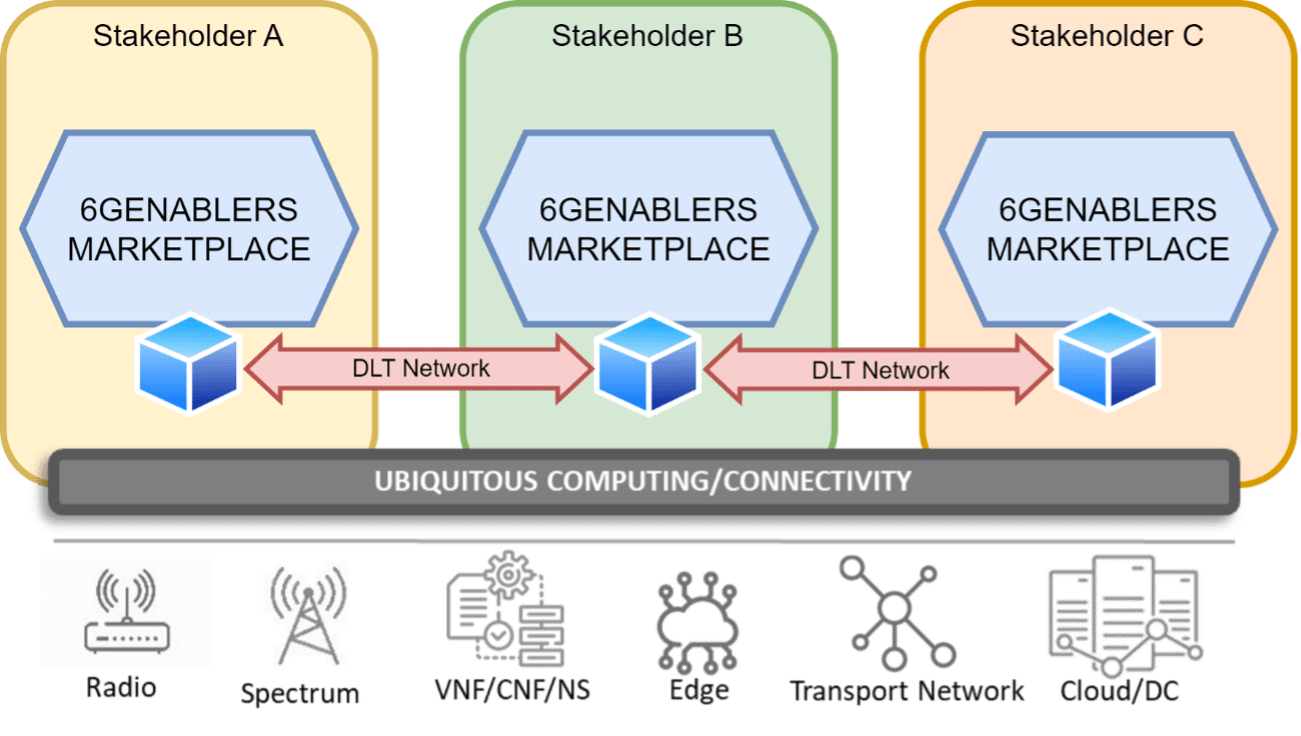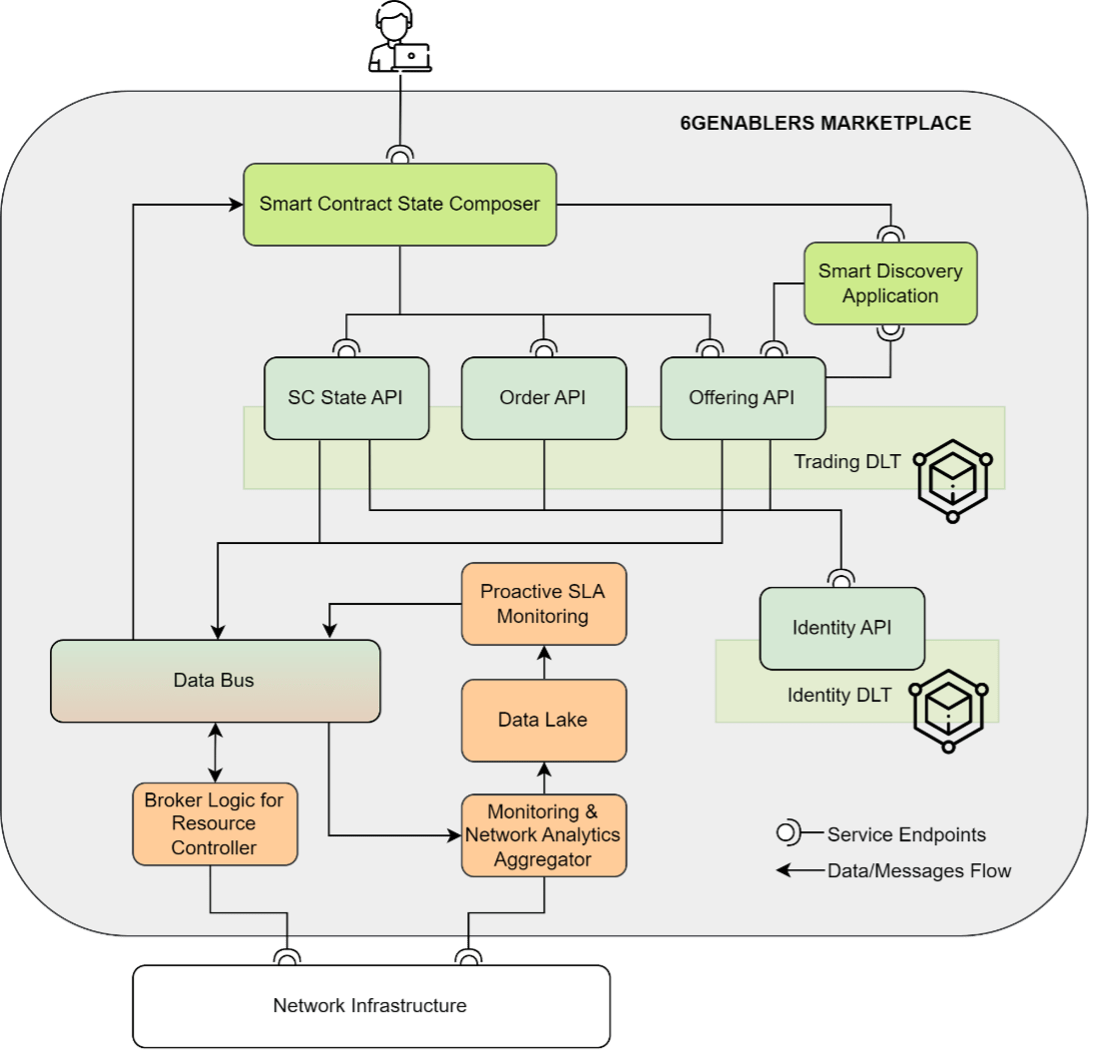
Keep up to date with our innovative initiatives.
Sign up here
The 6GENABLERS Marketplace stands as a pioneering solution, purposefully designed to address sustainable and ubiquitous needs integral to the evolution of 6G environments. In an era where the demand for seamless collaboration intersects with the imperative for sustainability, this decentralized platform emerges as a strategic response to propel the telecommunications industry into a more environmentally conscious and widely accessible future.
By fostering a collaborative ecosystem that transcends traditional boundaries, the 6GENABLERS Marketplace aligns with the sustainability objectives inherent to 6G. Its decentralized architecture not only enhances reliability and fault tolerance but also inherently contributes to resource optimization and energy efficiency. Using infrastructure sharing between multiple parties, the Marketplace promotes a sustainable model that resonates with the evolving landscape of next-generation networks.
The decentralized nature of the 6GENABLERS Marketplace is achieved by endowing each stakeholder with a Marketplace instance, which is interconnected with the rest of the participant instances through the DLT network. Using this network, the Marketplace participants are able to share softwarized network services and infrastructure components, providing ubiquitous computing and connectivity capabilities, which unlock the ability to furnish on-demand and pervasive service provisioning across domains.

Moreover, the permissioned nature of the Marketplace fosters a controlled and regulated environment, aligning with the privacy and security prerequisites crucial for the widespread adoption of 6G technologies. DLT serves as the bedrock of trust in the Marketplace, offering a decentralized ledger that records transactions across multiple nodes. This not only enhances transparency but also ensures the immutability of records, fostering a level of trust that is inherently resistant to tampering or unauthorized alterations. Participants within the 6GENABLERS Marketplace can transact with confidence, knowing that the integrity of the system is upheld through the robust and secure nature of DLT.
In embracing decentralization as a core design principle, the 6GENABLERS Marketplace not only safeguards against single points of failure but also inherently enhances trust. The distributed nature of the network, facilitated by DLT, ensures that trust is not reliant on a central authority but is distributed across the interconnected nodes, creating a resilient and trustworthy foundation for collaboration.
The high-level reference architecture of the 6GENABLERS Marketplace is split, from a functional point of view, across two distinct layers, namely the Business Layer and the Monitoring and Control Layer, being positioned on top of the Network Infrastructure. Each functional layer encapsulates diverse functionalities, adhering to a service-centric architectural model.

It is imperative to emphasize that the two strata of the 6GENABLERS Marketplace Architecture, i.e., Business Layer and Monitoring and Control Layer, intricately encapsulate the pivotal pillars of the 6ENABLERS-DLT project. These include four foundational functional systems, namely: DLT, governing secure and transparent participation; Smart Contracts, orchestrating automated and rule-based transactions; Smart Discovery, facilitating intent-based discovery of offers; and SLA Assurance, ensuring adherence to predefined agreements.
The figure above shows a single-domain instance of the 6GENABLERS Marketplace. This instance is replicated in every stakeholder domain. Regarding interaction, components belonging to the same stakeholder interact with each other through direct Application Programming Interface (API) calls or through the Data Bus, which bridges the two functional layers allowing asynchronous exchange between multiple components. Meanwhile, information propagation between the different stakeholder domains is conducted through the two considered DLT networks (Trading DLT and Identity DLT).
Author: Adriana Fernández-Fernández, PhD – Senior Researcher, Software Networks, i2CAT Foundation